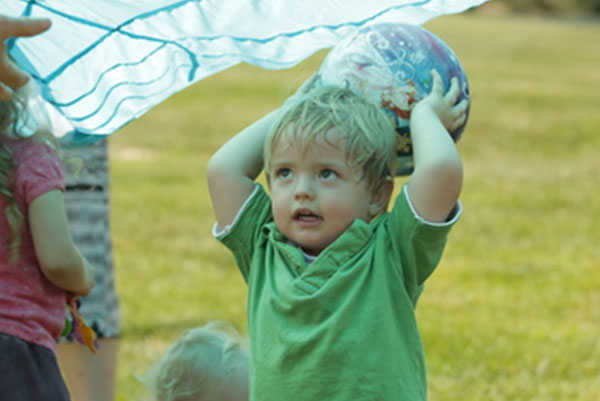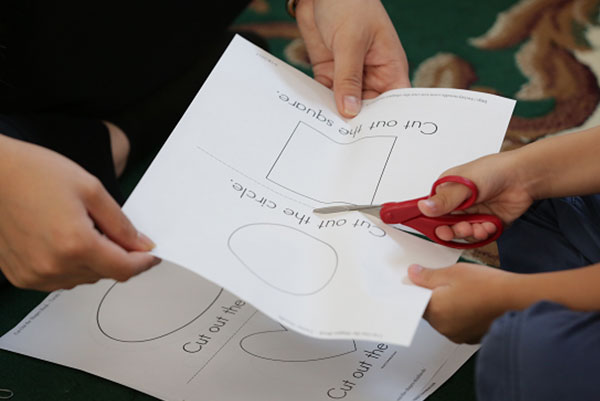Open Doors
Chapter 10: School Readiness Experience It
Home Visitor: Yeah, that's hard.
Mom: She knows about the magnet, magnets. So, she is doing like this to...
Home Visitor: Oh, yeah? Oh, she knows?
Mom: She did this.
Home Visitor: They have magnets, too, at the library in one of the sections.
Mom: Yeah, magnet, food magnets.
Home Visitor: Oh, yeah. You know, speaking --
Mom: And we have some letter with magnet.
Home Visitor: Like on the refrigerator to -- yeah.
Mom: We have board and --
Home Visitor: Oh, that's good.
Mom: Ohh, swing, swing.
Eleanor: Swing, swing. Swing, swing
Home Visitor: Swing, the fishy --
Mom: Fish is "swim," but Eleanor make it "swing.
Home Visitor: Well, that works. They're going for a swim.
Eleanor: Oh!
Home Visitor: It's okay. We can add it to it.
Eleanor: Allah!
Mom: [Speaking in Uyghur]
Eleanor: Allah!
Mom: When she was very young she just said, "Allah!" if she did something.
Home Visitor: That is funny.
Eleanor: Allah! [Babbling]
Home Visitor: Does that mean something? Or is she just saying...
Mom: It's like "oops." Oops. Instead of "Oops," "Allah."
Eleanor: Oops!
Home Visitor: You just made me think about when you were just talking about the library. I think I gave you a list before Eleanor was born for Allischer, but the library probably has good books about becoming a big brother and becoming a big sister.
Mom: Oh, yeah.
Home Visitor: That she, Allischer would understand even more, now since he's older. That could be good for over the summer.
Mom: Yeah.
Home Visitor: [Chuckles] Get them, get them in the mood.
Mom: [Speaking in Uyghur]
Home Visitor: You see the purple fish? So, you see the purple -- Mama has a purple fish. Ooh, so does Eleanor!
Mom: [Speaking in Uyghur] Swings!
Eleanor: Swing, swing.
Mom: Swing
Home Visitor: It is swinging. Oh, they're going to get -- You are too funny, girl.
Mom: Yesterday, she played with toy cars and she wants to get on and step on them. [Chuckles] I said,
"Let me sit here." [Speaking in Uyghur] [Chuckles]
Home Visitor: Purple? I like the fish. We're going to make a fish picture in a few minutes.
Mom: [Speaking in Uyghur]
Home Visitor: Lift it up and go fishing!
Eleanor: Swing, swing. Swing!
Home Visitor: Swing, swing! Everybody is swinging. You going to stand up and swing? That's a -- That is a good idea!
Eleanor: Swing. Allah!
Mom: [Speaking in Uyghur]
Eleanor: Thank you.
Mom: "Thank you." She is very gentle. And if I give her water or something, she says, "Mommy, thank you."
Home Visitor: She is just so verbal -- like over the last two months, she's had so many more words than before.
Mom: Swings.
Eleanor: Swing, swing.
Home Visitor: Swing! Oh! It went flying. Ooh! It went swimming.
Close

 How do perceptual, motor, and physical development goals relate to school readiness? The environment of a healthy womb and healthy habits established in the first five years of life lay a strong foundation for the physical and mental well-being needed for school success. The strength, balance, and coordination developing in the bodies of young children will grow into physical skills that allow them to pay attention; participate in games, active play, and sports; and use tools such as pencils, crayons, markers, and paint brushes. The ELOF provides a detailed progression of the knowledge and skills a child achieves in this domain.
How do perceptual, motor, and physical development goals relate to school readiness? The environment of a healthy womb and healthy habits established in the first five years of life lay a strong foundation for the physical and mental well-being needed for school success. The strength, balance, and coordination developing in the bodies of young children will grow into physical skills that allow them to pay attention; participate in games, active play, and sports; and use tools such as pencils, crayons, markers, and paint brushes. The ELOF provides a detailed progression of the knowledge and skills a child achieves in this domain. Fine motor development (e.g., development of the small muscles in the face) is the foundation for communication through facial expression. Fine motor development also provides our unique ability to use our fingers. It doesn't look like much in early infancy when babies who are just able to grasp a rattle can't even figure out how to release it. However, by age 3, they are using markers and paintbrushes, dressing themselves, using manipulative toys, and putting together puzzles. They are well on their way to having hands that build, write, turn pages, and create masterpieces.
Fine motor development (e.g., development of the small muscles in the face) is the foundation for communication through facial expression. Fine motor development also provides our unique ability to use our fingers. It doesn't look like much in early infancy when babies who are just able to grasp a rattle can't even figure out how to release it. However, by age 3, they are using markers and paintbrushes, dressing themselves, using manipulative toys, and putting together puzzles. They are well on their way to having hands that build, write, turn pages, and create masterpieces.